Download 40F 96
Transcript
40F 96 CONFIGURABLE FREQUENCY INDICATOR - INTERCEPTOR USER’S MANUAL SOFTWARE VERSION 1.0x code 81671B / edition 06 - 03/08 2 • TECHNICAL SPECIFICATIONS 1 • INSTALLATION • Dimensions and cut-out: Panel mounting Display 4 digit red LED’s, digit height 14mm Keys 3 mechanical keys (Raise, Lower, F) Accuracy 0.1% in autorange mode ± 1 digit with fixed f.s. Main input - mechanical contact, no voltage, configurable in opening/closing, 100Hz filter insertable from configuration - from logic control under voltage with amplitude 0.5...30 Vdc, 6 mA max, for proximity PNP or NPN (inductive or capacitive), encoder or NAMUR 2 or 3 wires - maximum frequency of input signal with duty cycle 50% settable 1, 2, 3, 4, 10, 20, 40, 100 KHz - from alternate control 30...500V peak, 1 mA max. maximum frequency 10KHz minimum frequency 0.5Hz in sinusoidal mode Scale limits -1999...9999 (settable decimal point) Can be converted into engineering units by inserting a multiplier or divisor (for example, for display / intercept of rpm) Sensor or transducer power supply 5Vdc, 12 Vdc, 120mA max 24 Vdc ± 10%, 50mA max filtered only Alarms (set points) Maximum of three configurable alarms: absolute, deviation, symmetrical deviation. Adjustable hysteresis Alarm masking - exclude on power-up - latch reset from key and/or external contact - insert delay filter (DON, DBI, DOF, DFO) - set minimum intervention time Relay contact NO (NC) 5A, 250V a cosϕ=1 108 96 115 48 70 44,5 92 105 10 ! For correct and safe installation, follow the instructions and observe the warnings contained in this manual. Panel mounting: Fix the device with the bracket provided before making any electrical connections. To mount two or more devices side by side, use the cut-out dimensions shown above. CE MARKING: EMC (electromagnetic compatibility) conformity to EEC Directive 89/336/CEE with reference to the generic Standard EN50082-2 (immunity in industrial environments) and EN50081-1 (emission in residential environments). BT (low voltage) conformity to Directive 73/23/CEE as modified by Directive 93/68. MAINTENANCE: Repairs must be done out only by trained and specialized personnel. Cut power to the device before accessing internal parts. Do not clean the case with hydrocarbon-based solvents (Petrol, Trichlorethylene, etc.). Use of these solvents can reduce the mechanical reliability of the device. Use a cloth dampened in ethyl alcohol or water to clean the external plastic case. SERVICE: GEFRAN has a service department. The warranty excludes defects caused by any use not conforming to these instructions. 81671B_MHW_40F96_0308_ENG Logic output type D 11Vdc, Rout = 220Ω (6V/20mA) Triac output (option) 20...240Vac ±10%, 3A max. Snubberless, inductive and resistive load I2t = 128A2S Logic input Ri = 5,6KΩ (24V, 4mA), 1500V isolation Logic input functions configurable for alarm memory reset, hold, flash, zero, selection of max., min. peak value, peakpeak Analog retransmission (option) 4 to 20mA, max. 150 Ω load Power supply (switching) (standard) 100...240Vac/dc ±10% max 11,5VA (optional) 11...27Vac/dc ±10% max 9VA 50/60Hz Fuse (inside device, not operator serviceable) 100 to 240Vac/dc - type T - 500mA - 250V 11 to 27Vac/dc - type T - 1.25A - 250V Faceplate protection IP65 Working / Storage temperatures 0 to 50°C / -20 to 70°C Relative humidity 20 to 85%, non-condensing Environmental conditions of use for internal use only, altitude up to 2000m Installation Panel mounting, extractable from front Weight 320g for the complete version EMC conformity has been tested with the following connections FUNCTION Input Power supply cable Relay output cables CABLE 1 mm2 1 mm2 1 mm2 LENGTH USED 3m 1m 3,5 m 1 3 • DESCRIPTION OF FACEPLATE Flashing LED: When frequency of input signal exceeds value set for parameter PS “Raise” and “Lower” keys: These keys are used for any operation that requires a numerical parameter to be raised or lowered. ••The speed of change is proportional to the time the key is pressed. •• The operation is not cyclic: once the maximum (minimum) limit is reached, there will be no further increase (decrease) of the value, even if the key remains pressed. The keys can be configured to perform reset, hold, display of the peak value, etc. as determined by the ‘t.U.’ and ‘t.d.’ parameters on the ‘In’ menu. PV display: Indication of process variable •• Indication of ‘HI’ or ‘Lo’ out of range •• Display of configuration messages Indication of output states: OUT 1 (Alarm 1); OUT 2 (Alarm 2); OUT 3 (Alarm 3) Label with engineering units Function key: Gives access to different configuration stages •• Confirms any parameter changes 4 • CONNECTIONS • Outputs Generic userconfigurable outputs 22 21 20 19 18 17 16 15 14 13 12 1 2 3 4 5 6 7 8 9 10 11 12 Out3 13 - relay 5A/250Vac - logic 6V/20mA, Rout = 220Ω (for Out 1, Out 2) - Triac 20...240Vac ±10% 3A max. 14 Out2 15 + 16 Out1 17 + TRIAC ~ Line ~ Load • Power supply Standard: 100 to 240Vac/dc ±10% Optional: 11 to 27Vac/dc ±10% 50/60Hz, 8VA max. ! ~ 11 PWR ~ 10 • Inputs • Mechanical contact Mechanical contact no voltage max. 100 Hz. • Logic input 4 Isolated digital input 1500V 3 Ri = 5,6KΩ (24V, 4mA) 2 6 • Retransmission output Analog output for retransmission External supply 5 8 - 7 + 4 to 20mA, Rmax. 150Ω + R 1 • Limit switch 3 wires /logic control Inductive or capacitive proximity NPN or PNP Input with sensitivity 0.5...30V, 6mA max 4 + 3 1 PNP S NPN - • Generator: AC Signal from voltage generator 30...500V peak, 1 mA max. 4 + 2 2 • Limit switch 2 wires Proximity NAMUR 12V 3 + 2 1 - 3 + - 4 To isolate the input, remove FL1 and R20 from base 2 ~ 1 81671B_MHW_40F96_0308_ENG Device structure: identification of boards CPU BOARD + POWER SUPPLY BOARD Sensor power supply OUTPUT BOARD S1 S3 5V ON OFF 12V OFF ON 24V OFF OFF S3 S1 FL1 R20 DISPLAY BOARD FL1, R20 on component side are to be removed to obtain isolation in case of high voltage AC input S1 CPU BOARD + POWER SUPPLY BOARD S2 S1 = Status of Out 1 relay S2 = Status of Out 2 relay S3 = Status of Out 3 relay B A B A = Direct B = Inverse A OUTPUT BOARD S3 B A 5 • PROGRAMMING and CONFIGURATION LEVEL 1 DISPLAY P.V. F Process variable IF Pressed for approx. 2 sec. PA PA = 99 Information display Alarm Setpoint Output 1 Alarm Setpoint Output 2 Alarm Setpoint Output 3 Password NO Keep the F key pressed to browse the menus. YES CF Hysteresis parameters Pr Protection code In Input settings U.C. User calibration Ou Output settings (*) (*) Release the F key to enter the displayed menu. Press the F key to access the parameters. Keep the F key pressed to exit any menu at any time. (*) For deviation alarms the setpoint range is -999 ... 999 If the Inc, Dec, F keys are not pressed within 15 sec., the display returns to the P.V. value • Information display IF Information display • Configuration parameters CF Hysteresis parameters Software version Hysteresis for set point 1 -999 ... +999 scale points Hysteresis for set point 2 -999 ... +999 scale points Hysteresis for set point 3 -999 ... +999 scale points Display of number of available outputs 81671B_MHW_40F96_0308_ENG 3 • Input parameters In • Output parameters Ou Input settings Output settings 0 to 3 Number of outputs Input configuration 0 Frequency - input NPN 1 Frequency - input PNP 2 AC input 1. t - 2. t - 3. t Frequency meter operating mode With FP = 0 or 2: Period corresponds to minimum frequency in input With FP = 1 or 3: Sampling time, TC = 0 update after 32 sec. Value Alarm type 1 0 Normal frequency value 1 Settable sampling time 2 Normal frequency value with fixed full scale 3 Sampling time settable with fixed full scale 0 1 2 3 4 5 6 7 Alarm type 2 0.0 ... 10.0sec Direct (max.) Inverse (min.) Direct Inverse Direct Inverse Direct Inverse Direct Inverse Alarm type 3 Absolute Normal Relative to Symmetrical previous (window) Absolute Absolute Relative Relative Absolute Absolute Relative Relative Normal Normal Normal Normal Symmetrical Symmetrical Symmetrical Symmetrical +8 to disable on power-up until first alarm +16 to memorize +32 to filter with F.O. mode (output filter mode) Selection of full scale frequency 0 1 2 3 4 (*) 5 (*) 6 (*) 7 (*) Max. frequency in input 1KHz 2KHz 4KHz 10KHz 20KHz 40KHz 80KHz 100KHz Prescaler ratio 1 2 4 2 4 8 16 32 0 not active: calculated status is sent directly to relay 1 On delay (DON) 2 delay activation from time of deactivation of output (DBI) 3 Off delay (DOF) 4 Delay for activation only at power-up (DPO) Output filter mode +8 enable MU, dE parameters (*) value shown indicates frequency /10 see application example + 8 time base max. 99 min (default = 99 sec) Multiplier 1 ... 255 delay for F.O. 0 to 99 min or sec Divisor 1 ... 255 Minimum output pulse 0 to 99 sec Disabled by setting value 0 Displayed if associated with at least one output Main input filter ON / OFF ON = 100Hz filter dP 0 1 2 3 Decimal point position for full scale Format XXXX XXX.X XX.XX X.XXX Determines full scale of retransmitted output and alarms N.B.: valid only for frequencies with fixed full scale; automatic shift of Dp for higher frequencies Selection of digital input 1 Raise key function (active only in P.V.selection) Lower key function (active only in P.V.selection) 0 1 2 3 4 5 6 7 8 9 10 11 12 13 14 15 4 None Zero Hold Flash Max. peak display Min. peak display Delta peak display Peak memory reset Zero + peak memory reset Alarms reset Peak + alarms reset Zero + alarms reset Peak + zero + alarms reset Output status OUT1 Output status OUT2 Output status OUT3 Minimum scale analog repeat output -1999 ... 9999 Maximum scale analog repeat output -1999 ... 9999 • Protection Value Pr Protection code 0 1 2 3 Displayed parameters o.1, o.2, o.3 o.1, o.2 o.1 o.1 Modifiable parameters o.1, o.2, o.3 o.1, o.2 o.1 none +4 to disable In and Ou pages +8 to disable Cf page +32 base configuration (the following parameters will not be displayed: In: FI, L_L, H_L Ou: On [forced to no. outputs present]) • User Calibration U. C. U.C. 1 CPU F Function analog retransmission output Calibration of minimum (*) Low limit for the alarms set point -1999 ... 9999 High limit for the alarms set point -1999 ... 9999 Calibration of maximum (*) (*) when U.C. = 1 press keys ∆ analog output ∇ to calibrate 81671B_MHW_40F96_0308_ENG • HOLD function The input value and alarms are frozen while the logic input is active. With the logic input active, a reset turns OFF both the relay outputs and the alarms latch. • FLASH function Input value is sampled; state of alarms is not transferred to outputs; outputs are “frozen”. When the logic input is active the input value is “frozen” and the outputs are updated according to the calculated alarms state, including the ones latched. 6 • ALARMS Normal absolute alarm Symmetrical absolute alarm AL2 AL1 + [ H1 ] AL2 + H2 AL1 + H1 AL1 AL1 AL1 - [ H1 ] time alarm 1 (*) time inverse direct alarm 2 For AL1 inverse absolute alarm (min.) with positive H1, 1 t = 1 (*) = OFF if disabling on power-on exists For AL2 direct absolute alarm (max) with negative H2, 2 t = 0 For AL1 inverse absolute, symmetrical alarm with hysteresis H1, 1 t = 5 For AL1 direct absolute, symmetrical alarm with hysteresis H1, 1 t = 4 Normal deviation alarm (AL1 absolute, AL2 relative) Symmetrical deviation alarm (AL1 absolute, AL2 relative) AL1+AL2 AL1 + AL2 + H2 AL1+AL2 AL1+AL2+H2 AL1 AL1 + H1 AL1 AL1+H1 AL1-AL2 time time alarm 1 alarm 1 alarm 2 alarm 2 For AL1 direct absolute alarm (max) with negative H 1, 1 t = 0 For AL2 direct relative alarm (max) with negative H2, 2 t = 2 81671B_MHW_40F96_0308_ENG For AL1 direct absolute alarm (max) with negative H1, 1 t = 0 For AL2 symmetrical deviation alarm H2, 2 t = 6 5 • Filter - outputs with reference to parameters F.0 and r.A The diagrams refer to a normal absolute alarm with hysteresis H = 0 F.0 = 2 DBI = Delay in turning on output after output is turned off F.0 = 1 DON = Delayed activation Alarm setpoint Alarm setpoint Variable Variable Output Output Alarm Alarm rA rA rA time t < rA time t > rA t < rA F.0 = 3 DOF = Delayed deactivation F.0 = 4 DP0 = Delayed activation only at power-on Alarm setpoint Alarm setpoint Variable Variable Output Output Alarm Alarm rA rA rA rA time time Applicative example Configure the instrument to show motor axle speed in rpm, connected to an encoder as per the diagram. MOTOR Dpm ωm ENCODER Dpe Ke ωe f Dpe = encoder pulley diameter [ m ] Dpm = motor pulley diameter [ m ] ωe = encoder angular velocity [ rpm ] ωm = motor angular velocity [ rpm ] Ke = number of pulses per encoder rev [ clock / rev ] τ= ωe ωm = Dpm Dpe = drive ratio f = frequency in input to instrument [ Hz ] • ωe 1 • Ke • Ke 60 Ks is defined as multiplicative constant of instrument: 1 Value shown [ rpm ] = Ks • f = Ks • 6 • 60 ωm • Dpm Dpe 81671B_MHW_40F96_0308_ENG Ks = Ks numerator Ks denominator MU = Ks numerator • fs dE = Ks denominator where: fs = full scale [ KHz ] (can be chosen from 1, 2, 4, 10, 20, 40, 100KHz according to max. frequency in input) MU = multiplier dE = divisor These parameters can be set on the “In” menu EXAMPLE 1 Dpm = 80 mm (motor pulley diameter) Dpe = 160 mm (encoder pulley diameter) Ke = 250 clock / rev = number of pulses per encoder rev ωm maximum = 3000 rpm Maximum frequency at input of the instrument must be determined to define full scale fs. 1 Dpm fmax = • (ωm maximum) • • Ke = 6250 Hz 60 Dpe fs = 10 KHz (value of parameter P.S corresponding to a full scale of 10KHz is 11) 12 Ks numerator 60 • Dpe 60 • 160 = = = Ks = 25 Ks denominator Ke • Dpm 250 • 80 After reducing the function to minimum terms, determine MU and dE (numerator and denominator): P.S = 3, MU = 120, dE = 25 EXAMPLE 2 To show the rpms of a wheel with 250 pulses/rev, with max. frequency less than 1 kHz, set FP = 0, P.S = 8 (full scale 1 KHz), MU = 6, dE = 25 EXAMPLE 3 For applications requiring greater precision of frequency value (with max. full scale 500 Hz), you can set a sampling time greater than one second. To show the frequency in pulses/second with fixed scale, with one decimal figure and with sampling time at a constant 5 sec, set FP=3, tc =5.0 sec, P.S = 8 (full scale 1 KHz), MU = 1, dE = 5, dP = 1 EXAMPLE 4 Calculation of frequency displayed (F.v.) with a proximity input With a full scale of 20KHz, the assigned prescaler ratio is 4; therefore the value shown is: Input Frequency F.v. = Mu • Prescaler Ratio dE es.: Ps = 12 (Fmax. 20KHz) Prescaler Ratio = 4 Mu = 3 dE = 7 Input Frequency Frequenza ingresso F.v. = 3 • 4 = 214,2 7 7 • ACCESSORIES • RS323 interface cable for configuration N.B.: the PC configuration cable is supplied with the programming software. WARNING: make the connection with the device powered and with inputs and outputs disconnected. • ORDER CODE COD. 1108200 81671B_MHW_40F96_0308_ENG Cable + Floppy 7 ORDER CODE 40F 96 4 Sensor power supply Power supply 5Vdc, 120mA 05 0 11 to 27Vac/dc 12Vdc, 120mA 12 1 100 to 240Vac/dc 24Vdc, 50mA 24 Digital input / Retransmission output Output 1, Output 2 Relay, Relay RR Relay, Static D2 RD Triac, None T0 0 None 1 Digital input 3 Digital input + Retransmission output 4...20mA on max 150Ω 0 None R Relay Output 3 Kindly contact GEFRAN for information on available codes. • WARNINGS ! WARNING: this symbol indicates danger. It is seen near the power supply circuit and near high-voltage relay contacts. Read the following warnings before installing, connecting or using the device: • follow instructions precisely when connecting the device. • always use cables that are suitable for the voltage and current levels indicated in the technical specifications. • the device has no ON/OFF switch: it switches on immediately when power is turned on. For safety reasons, devices permanently connected to the power supply require a two-phase disconnecting switch with proper marking. Such switch must be located near the device and must be easily reachable by the user. A single switch can control several units. • if the device is connected to electrically NON-ISOLATED equipment (e.g. thermocouples), a grounding wire must be applied to assure that this connection is not made directly through the machine structure. • if the device is used in applications where there is risk of injury to persons and/or damage to machines or materials, it MUST be used with auxiliary alarm units. You should be able to check the correct operation of such units during normal operation of the device. • before using the device, the user must check that all device parameters are correctly set in order to avoid injury to persons and/or damage to property. • the device must NOT be used in inflammable or explosive environments. It may be connected to units operating in such environments only by means of suitable interfaces in conformity to local safety regulations. • the device contains components that are sensitive to static electrical discharges. Therefore, take appropriate precautions when handling electronic circuit boards in order to prevent permanent damage to these components. Installation: installation category II, pollution level 2, double isolation • power supply lines must be separated from device input and output lines; always check that the supply voltage matches the voltage indicated on the device label. • install the instrumentation separately from the relays and power switching devices • do not install high-power remote switches, contactors, relays, thyristor power units (particularly if “phase angle” type), motors, etc... in the same cabinet. • avoid dust, humidity, corrosive gases and heat sources. • do not close the ventilation holes; working temperature must be in the range of 0...50°C. If the device has faston terminals, they must be protected and isolated; if the device has screw terminals, wires should be attached at least in pairs. • Power: supplied from a disconnecting switch with fuse for the device section; path of wires from switch to devices should be as straight as possible; the same supply should not be used to power relays, contactors, solenoid valves, etc.; if the voltage waveform is strongly distorted by thyristor switching units or by electric motors, it is recommended that an isolation transformer be used only for the devices, connecting the screen to ground; it is important for the electrical system to have a good ground connection; voltage between neutral and ground must not exceed 1V and resistance must be less than 6Ohm; if the supply voltage is highly variable, use a voltage stabilizer for the device; use line filters in the vicinity of high frequency generators or arc welders; power supply lines must be separated from device input and output lines; always check that the supply voltage matches the voltage indicated on the device label. • Input and output connections: external connected circuits must have double insulation; to connect analog inputs (TC, RTD) you have to: physically separate input wiring from power supply wiring, from output wiring, and from power connections; use twisted and screened cables, with screen connected to ground at only one point; to connect adjustment and alarm outputs (contactors, solenoid valves, motors, fans, etc.), install RC groups (resistor and capacitor in series) in parallel with inductive loads that work in AC (Note: all capacitors must conform to VDE standards (class x2) and support at least 220 VAC. Resistors must be at least 2W); fit a 1N4007 diode in parallel with the coil of inductive loads that operate in DC. GEFRAN spa will not be held liable for any injury to persons and/or damage to property deriving from tampering, from any incorrect or erroneous use, or from any use not conforming to the device specifications. 8 81671B_MHW_40F96_0308_ENG








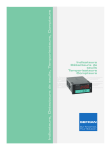
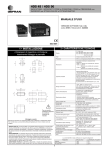
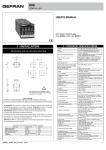

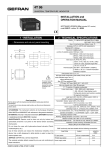
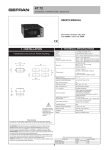
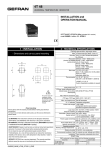
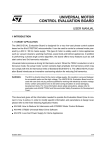
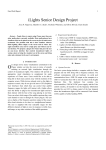
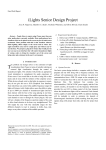
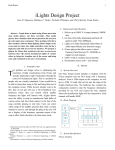

![Indicateurs (PDF/782Ko) [F]](http://vs1.manualzilla.com/store/data/006364555_1-61d6515c96ce437ed2545f3e53fb26c1-150x150.png)